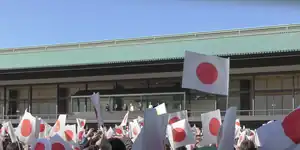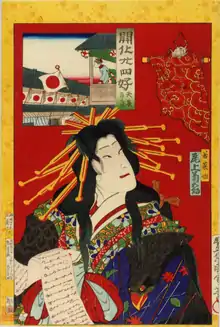The Emperor's Birthday
The Emperor's Birthday (天皇誕生日, Tennō tanjōbi) is an annual Public holiday in Japan celebrating the birthday of the reigning Emperor, which is currently 23 February as Emperor Naruhito was born on that day in 1960. It is enforced by a specific law, "The Law for Special Exception of the Imperial House Law concerning Abdication, etc. of Emperor" (天皇の退位等に関する皇室典範特例法) of 2017.[1]
| Ritual ceremonies of the Imperial Palace |
| Shihohai・Saiten-sai |
| Genshi-sai |
| Start of Musical Performance |
| Emperor Showa Festival (Previous Emperor's Festival) |
| Emperor Kōmei festival[lower-alpha 1] |
| Prayer for Good Harvest |
| The Emperor's Birthday |
| Spring Kōreisai・Spring Shrine Festival |
| Jimmu Festival・Kōrei-den Kagura |
| Empress Kōjun festival[lower-alpha 1] |
| Yoori・Oharae |
| Emperor Meiji festival[lower-alpha 1] |
| Autumn Imperial Spirit Festival (秋季皇霊祭)・Autumn Shrine Festival (秋季神殿祭) |
| Kannamu-sai |
| Niiname-no-Matsuri |
| Kashiko dokoro Sacred Kagura |
| Emperor Taishō festival[lower-alpha 1] |
| Yoori・Ōharae-shiki |
| Emperor's Birthday | |
|---|---|
 Well-wishers waving flags at the Tokyo Imperial Palace on Emperor Akihito's birthday in 2017 | |
| Official name | Tennō tanjōbi (天皇誕生日) |
| Also called | Tenchōsetsu (天長節) (−1948) |
| Observed by | Japan |
| Type | Public |
| Significance | Marks the birthday of the Emperor of Japan |
| Celebrations | Public ceremony at the Tokyo Imperial Palace, imperial greetings |
| Date | 23 February |
| Next time | 23 February 2024 |
| Frequency | Annual |
History of holiday
Ancient – medieval
The name of Tenchosetsu (天長節) is ancient, and derived from the birthday of Emperor Xuanzong of Tang. It was changed to "Chiaki-bushi (千秋節)" in 729 in the first year of Tenpyō, but it was renamed to "Tencho-setsu" (天長節) in the 7th year of Tenpyo (748 in the first year of Katsuho) 19 years later. "Tencho" (天長) is taken from Laozi's "Tencho Chikyu" (天長地久).[2]
In Japan, Emperor Kōnin's Hōki 6th year (775) 13 October (10 November, Gregorian calendar), the Emperor's Birthday ceremony was held. His vassals presented the emperor's favorite sake and gave him a feast.
Omi Tencho Daisui Group Omi Dedication Good Sake Food Feast (是日天長大酺群臣献翫好酒食宴畢賜禄有差)
(Previously, on 11 September (10 October, Gregorian calendar)
October 13th, every day of birth, every year, the priests of the temples, the priests of the temples The Emperor's Birthday (十月十三日是朕生日毎至此辰威慶兼集宜令諸寺僧尼毎年是日転経行道海内諸国竝宜断屠内外百官賜酺宴一日仍名此日為天長節庶使廻斯功徳虔奉先慈以此慶情普被天下)
The Emperor's birthday was already celebrated during the Heian period. This is recorded in the record of Hōki 10 (779). There is also a description in the "Oyudono Diary" (お湯殿の上の日記) as a record of the Muromachi period.
Modern – contemporary

On 26 August 1868 (11 October 1868), a decree by the Daijo-kan said, "22 September, the Emperor's Birthday is equivalent to the Emperor's Birthday. On 22 September (6 November 1868), the Emperor's Birthday was celebrated as a national holiday. In the 2nd year of the Meiji era (1869), the ministers of each country were invited to the Enryokan to receive a drink, and in the 3rd year of the Meiji era (1870), various officials, non-employees, Kazoku, etc. worshiped. The ministers and below received a feast at each ministry, and royal gun salute was shot on various warships. The ritual of the Emperor's Festival was completed in 1872, in the same year of the Emperor's Birthday.
Until 1948, it was called Tenchōsetsu (天長節), "Tenchō Festival".[3] Tenchōsetsu paralleled Chikyūsetsu (地久節), "Chikyū Festival", which referred to the Empress consort's birthday.[3] The two names originate from the idiom in Chinese: 天長地久, borrowed from Lao Tzu's Tao Te Ching during the reign of Emperor Kōnin (708–782 CE), meaning "The sky and the earth, the universe is eternal," and expressed a hope for the eternal longevity of the reigning Emperor. After World War II in 1948, the government renamed it to Tennō tanjōbi (天皇誕生日)-- the literal translation of emperor's birthday--and made the day a public holiday.[3] Under the law, when the throne passes to a new Emperor, the National Diet must convene and change the holiday date's to that of the new Emperor's birthday.[4][3] Thus, there exists a small chance that the former Emperor's birthday may come before the change can be made.
During the reign of Emperor Hirohito (the Shōwa period, 1926–1989), the Emperor's birthday was observed on 29 April.[5] That date remained a public holiday, posthumously renamed Greenery Day in 1989 and Shōwa Day in 2007.[6]
On 30 April 2019, the 125th Emperor Akihito abdicated as per the Constitution of Japan and in accordance with the Imperial Code Special Law Concerning the Retirement of the Emperor. Because Akihito's birthday is December 23, and his successor Naruhito's is 23 February, 2019 was the first year since the introduction of the Holidays Act in 1948 that there were no Emperor's Birthday celebrations.[7]
Because of concerns related to the COVID-19 pandemic, the public celebrations for Naruhito's birthday were cancelled in 2020 (Reiwa 2),[8][9][10] 2021 (Reiwa 3)[8][11] and 2022 (Reiwa 4).[8][12][13] However, the emperor addressed and thanked the public for their wishes in a press conference[14] and a recorded video message[15] 2020 and 2021 respectively.
Observance

Many citizens write letters to the Emperor during the week leading up to his birthday, and hang the Japanese flag the day of.[3]
On the Emperor's Birthday, a public ceremony takes place at the Tokyo Imperial Palace, where the gates are opened (the palace is usually off-limits to the public).[16][3] Usually only the surrounding park can be visited.[16] The emperor, accompanied by the empress, and several other members of the imperial family appear on a palace balcony to acknowledge the birthday greetings of well-wishers waving Japanese flags.[16][3] This event is called Ippan-sanga (一般参賀). Only on this occasion, and during New Year's celebrations on 2 January, are members of the public permitted to enter the inner grounds of the palace.[17][4][3] The crowd must wait in an orderly manner in a pre-established area between the main road and the building: at a later time the police accompany visitors, guiding them from the square in front of them to the inside of the building.[16] Admission is free and those who wish are given a small Japanese flag.[16][3] The area in front of the reception pavilion is called Chōwaden. Visitors wait in line next to the Nijubashi bridge, at around 9:30 in the morning the police make a first group of people cross the bridge and manage the entrance to the square below the balcony. At around 10:20 am, the emperor, accompanied by the empress, the heirs to the throne and their respective spouses, looks out on the balcony and the crowd below wishes the emperor long life by repeating the word "banzai" in chorus which means "ten thousand years" (for the Emperor).[16][3] On the day of the holiday, the Imperial Palace complex and the surrounding streets are guarded by police, which, according to tradition, hand out small flags of Japan at the gate for free. Citizens may also bring their own if they wish.[3]
Once his thanks and public greetings are concluded, the crowd begins to wave flags and the Imperial Family retreats inside the palace.[18] The ceremony lasts three minutes in all, after which the group of subjects is guided outside, and a second group is allowed to enter. This operation is repeated several times, so that as many citizens as possible can pay homage to the emperor.[16] The same evening, national television broadcasts a special during which the emperor addresses a few words of thanks to the country.[19]
The crowd that attends the ceremony usually consists of adults and elderly people.[18] Among the crowd, there may also be groups of foreign tourists who organize palace visits and enjoy the event.[18]
Song
- "The Emperor's Birthday (Tenchōsetsu)" (天長節) (lyrics Mayori Kurokawa, composer Yoshisa Oku): Meiji 26 years (1893 was enacted) as "a holiday festival date song".[20]
Lyrics
These are the lyrics of the song.[21]
| 今日の吉き日は 大君の | Kyō no yoki hi wa ōkimi no | Today's blessing day is His Majesty's |
| うまれたまひし 吉き日なり | Umare tamaishi yoki hi nari | Day of birth, truly a blessing day |
| 今日の吉き日は みひかりの | Kyō no yoki hi wa mihikari no | Today's blessing day is when the glorious light |
| さし出たまひし 吉き日なり | Sashide tamaishi yoki hi nari | Shines in, truly a blessing day |
| ひかり遍き 君が代を | Hikari amaneki kimi ga yo o | Lights are all over your reign |
| いはへ諸人 もろともに | Iwae morobito morotomo ni | Let us subjects celebrate, as one |
| めぐみ遍き 君が代を | Megumi amaneki kimi ga yo o | Graces are all over your reign |
| いはへ諸人 もろともに | Iwae morobito morotomo ni | Let us subjects celebrate, as one |
天長節 (Tenchōsetsu), The Emperor's Birthday, 1893
List of emperors' birthdays
| Era | Emperor | Years | Date |
|---|---|---|---|
| Meiji | Emperor Meiji | 1868–1872 | 22 September (Lunisolar calendar) |
| 1873–1911 | 3 November | ||
| Taishō | Emperor Taishō | 1912–1913 | 31 August |
| 1914–1926 | 31 October | ||
| Shōwa | Emperor Shōwa | 1927–1988 | 29 April |
| Heisei | Emperor Akihito | 1989–2018 | 23 December |
| Reiwa | Emperor Naruhito | 2020– | 23 February |
Notes
- This is an example festival. The last three emperors have their festivals celebrated
References
- "「国民の祝日」について" [About "national holiday"]. Cabinet Office (Japan). Archived from the original on 29 March 2021. Retrieved 23 February 2021.
- 『年中行事事典』p512 昭和33年(1958年)5月23日初版発行 西角井正慶編 東京堂出版
- "The Emperor's Birthday 2023, 2024 and 2025".
- "Tenno No Tanjobi celebrates the Emperor's birthday in Japan". TokyoTopia Or Tokyo Made Simple. Archived from the original on 24 June 2013. Retrieved 23 December 2009.
- "Emperor Hirohito". Spartacus Educational. Retrieved 23 December 2009.
- "Golden Week". japan-guide.com. Archived from the original on 25 January 2021. Retrieved 23 December 2009.
- "初めて天皇誕生日なし 政府が19年の祝日発表". 日本経済新聞 電子版 (in Japanese). Archived from the original on 13 August 2020. Retrieved 20 November 2018.
- "His Majesty's Birthday Receptions". The Imperial Household Agency.
- "Emperor's birthday event canceled due to coronavirus outbreak".
- "Japan Cancels Emperor Naruhito's Birthday Celebrations Amid Coronavirus Scare".
- "On his birthday, Japanese Emperor hopes for bright future amid pandemic". Reuters. 23 February 2021.
- "Visit of the General Public to the Palace for His Majesty's Birthday". The Imperial Household Agency. Retrieved 23 February 2023.
- "Birthday Ceremonies for Emperor Naruhito Scaled Down". 23 February 2022.
- "Japan Emperor, Turning 60, Resolved to Fulfill State Symbol Role". 23 February 2020.
- "EDITORIAL: Reiwa Emperor Reaches Out, Empowers the People on his Birthday". Japan Forward. 25 February 2021. Archived from the original on 26 February 2021. Retrieved 28 February 2021.
- "Tennō tanjōbi (天皇誕生日)". kazegafukuhi.livejournal.com. 23 December 2006. Archived from the original on 9 August 2020. Retrieved 21 November 2012.
- "Visit of the General Public to the Palace for the New Year Greeting". Imperial Household Agency. Archived from the original on 16 November 2020.
- "Tenno Tanjoubi: Il compleanno dell'Imperatore". Sakura Magazine. Archived from the original on 5 January 2013. Retrieved 21 November 2012.
- "La famiglia imperiale giapponese". tuttocina.it. Archived from the original on 19 June 2017. Retrieved 21 November 2012.
- "The Emperor's Birthday" (天長節)". National Diet Library. 1 January 2011. Archived from the original on 30 March 2021.
- "Tenchō Festival, Tenchō setsu". YouTube. 22 February 2021. Archived from the original on 30 March 2021.